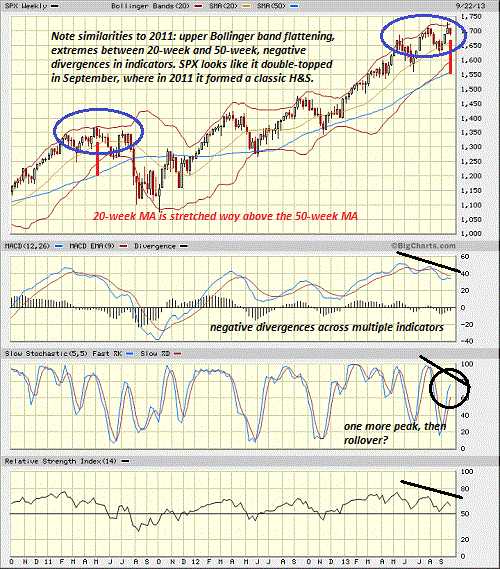One More "The Status Quo Is Saved" Rally and Then...?
We can anticipate another rally once the political charade plays out, but what happens after that?
We can safely predict the inevitable budget-debt ceiling deal will spark yet another "the Status Quo is saved" rally in the stock market. But what happens after that?
Here is a three-year chart of the S&P 500 (SPX). The potential for another spike higher is reflected in the rising stochastics.
But overall, the chart is showing weakness and the potential for a serious decline.The negatives include:
1. A number of indicators (MACD and relative strength) are negatively divergent, i.e. they are declining as price moves higher
2. The 20-week moving average (MA) is stretched above the 50-week MA (i.e. the market has reached a point where the 20-week tends to converge with the 50-week MA)
3. The upper Bollinger band is flattening, showing loss of momentum.

Some similarities with 2011 are discernable. In 2011, a multi-month topping process traced out a classic head-and-shoulders pattern. This year, the chart has a similar structure of divergence, with a potential double top in play or even a spike higher to a nominal new high in the the 1750-1775 area--a target that some technical analysts have forecast for quite some time.
Regardless of whether the market double-tops or hits new nominal highs, the set-up for an extended decline is already in place technically. All this can change, of course; negative divergences can reverse, and a new uptrend can push indicators into bullish territory. But until that happens, the bearish indicators bear watching.
The Nearly Free University and The Emerging Economy:
The Revolution in Higher EducationReconnecting higher education, livelihoods and the economyWith the soaring cost of higher education, has the value a college degree been turned upside down? College tuition and fees are up 1000% since 1980. Half of all recent college graduates are jobless or underemployed, revealing a deep disconnect between higher education and the job market.
It is no surprise everyone is asking: Where is the return on investment? Is the assumption that higher education returns greater prosperity no longer true? And if this is the case, how does this impact you, your children and grandchildren?

We must thoroughly understand the twin revolutions now fundamentally changing our world: The true cost of higher education and an economy that seems to re-shape itself minute to minute.
The Nearly Free University and the Emerging Economy clearly describes the underlying dynamics at work - and, more importantly, lays out a new low-cost model for higher education: how digital technology is enabling a revolution in higher education that dramatically lowers costs while expanding the opportunities for students of all ages.
The Nearly Free University and the Emerging Economy provides clarity and optimism in a period of the greatest change our educational systems and society have seen, and offers everyone the tools needed to prosper in the Emerging Economy.
Read the Foreword, first section and the Table of Contents.
print edition (list $20, now $18)
Kindle edition: list $9.95
Things are falling apart--that is obvious. But why are they falling apart? The reasons are complex and global. Our economy and society have structural problems that cannot be solved by adding debt to debt. We are becoming poorer, not just from financial over-reach, but from fundamental forces that are not easy to identify. We will cover the five core reasons why things are falling apart:
 1. Debt and financialization
1. Debt and financialization2. Crony capitalism
3. Diminishing returns
4. Centralization
5. Technological, financial and demographic changes in our economy
Complex systems weakened by diminishing returns collapse under their own weight and are replaced by systems that are simpler, faster and affordable. If we cling to the old ways, our system will disintegrate. If we want sustainable prosperity rather than collapse, we must embrace a new model that is Decentralized, Adaptive, Transparent and Accountable (DATA).
We are not powerless. Once we accept responsibility, we become powerful.
Kindle: $9.95 print: $24
| Thank you, Eric T. ($100), for your outrageously generous contribution to this site-- I am greatly honored by your steadfast support and readership. |



























